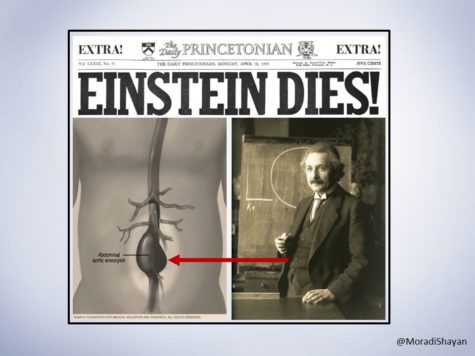It was the April of 63 years ago on a nice spring day, when the world received shocking news: Albert Einstein, one of the eminent minds of the world was dead.
The reason: a rupture in his abdominal aortic aneurysm (AAA).
AAAs are progressive luminal dilations of abdominal aorta which are asymptomatic affecting more than 3 million Americans per year with an 80% mortality rate following rupture. After all these years, we are still struggling to fully understand the mechanism behind AAAs and the main improvements have been made in surgical techniques that address the pathology in the advanced stages. Moreover, there are currently no validated pharmaceutical approaches that can address different stages of AAAs.

Figure 1: Einstein died of a rupture in his abdominal aortic aneurysm at 76
One of the reasons behind these shortcomings is mainly the complicated characteristics of the disease involving many different cell types at various layers of the aorta. Although analysis of human surgical samples have been able to expand our understandings about AAAs, it should be noted that these samples are acquired at the advanced stages of AAA which fail to contribute to our understanding about initiation phase of the disease. However, in the last few years, there have been many efforts to shed more light on the pathophysiology of AAAs by using animal models of AAAs.
Lesson learned from such studies show that AAA pathological hallmarks include an increased local inflammation in the aortic tissue which can be further augmented by proteolytic degradation of extracellular matrix and depletion of vascular smooth muscle cells. There are several pro-inflammatory pathways which have been reported to participate in AAA initiation, however, as I described in my previous blog post, the toll-like receptor 4 (TLR4) signaling pathway seems to be a key player.
Our laboratory’s previous studies were among the first to show that whole body deficiency of TLR4 can ablate the angiotensin II (angII)-induced AAA in low-density lipoprotein receptor deficient (LDLR-/-) mice. Other research endeavors using different mice background or other AAA animal models also further confirmed the critical role of TLR4 in AAAs.
Although these studies clearly show the role of TLR4 in AAAs, further research is needed to understand which cell types are responsible for TLR4 protective effects and via which mechanisms. As a researcher in this field, my current focus is on targeting aortic cell-specific TLR4 and how these cell-specific receptors contribute to the pathology. These understandings have the potential to contribute to the development of pharmaceutical approaches that can specifically target the cell receptors and prevent/slow the progression of the pathology.
Albert Einstein once said “The only source of knowledge is experience” and I hope after years of experience in studying AAAs, we finally get to find pharmaceutical strategies than can help millions of patients.

Shayan is a caffeine-dependent Ph.D. Candidate at the Saha Cardiovascular Research Center, University of Kentucky. His research area is focused on vascular biology and lipid metabolism. He tweets @MoradiShayan, blogs at shayanmoradi.com and he is the Winner of World’s Best Husband Award (Category: nagging).